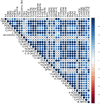High levels of eicosanoids and docosanoids in the lungs of intubated COVID-19 patients
- PMID: 34033145
- PMCID: PMC8206770
- DOI: 10.1096/fj.202100540R
High levels of eicosanoids and docosanoids in the lungs of intubated COVID-19 patients
Abstract
Severe acute respiratory syndrome coronavirus 2 is responsible for coronavirus disease 2019 (COVID-19). While COVID-19 is often benign, a subset of patients develops severe multilobar pneumonia that can progress to an acute respiratory distress syndrome. There is no cure for severe COVID-19 and few treatments significantly improved clinical outcome. Dexamethasone and possibly aspirin, which directly/indirectly target the biosynthesis/effects of numerous lipid mediators are among those options. Our objective was to define if severe COVID-19 patients were characterized by increased bioactive lipids modulating lung inflammation. A targeted lipidomic analysis of bronchoalveolar lavages (BALs) by tandem mass spectrometry was done on 25 healthy controls and 33 COVID-19 patients requiring mechanical ventilation. BALs from severe COVID-19 patients were characterized by increased fatty acids and inflammatory lipid mediators. There was a predominance of thromboxane and prostaglandins. Leukotrienes were also increased, notably LTB4 , LTE4 , and eoxin E4 . Monohydroxylated 15-lipoxygenase metabolites derived from linoleate, arachidonate, eicosapentaenoate, and docosahexaenoate were also increased. Finally yet importantly, specialized pro-resolving mediators, notably lipoxin A4 and the D-series resolvins, were also increased, underscoring that the lipid mediator storm occurring in severe COVID-19 involves pro- and anti-inflammatory lipids. Our data unmask the lipid mediator storm occurring in the lungs of patients afflicted with severe COVID-19. We discuss which clinically available drugs could be helpful at modulating the lipidome we observed in the hope of minimizing the deleterious effects of pro-inflammatory lipids and enhancing the effects of anti-inflammatory and/or pro-resolving lipid mediators.
Keywords: COVID-19; docosanoids; eicosanoids; eoxins; specialized pro-resolving mediators; thromboxane.
© 2021 The Authors. The FASEB Journal published by Wiley Periodicals LLC on behalf of Federation of American Societies for Experimental Biology.
Conflict of interest statement
The authors have stated explicitly that there are no conflicts of interest in connection with this article.
Figures





References
-
- Damiani S, Fiorentino M, De Palma A, et al. Pathological post mortem findings in lungs infected with Sars‐Cov 2. J Pathol. 2020. - PubMed
Publication types
MeSH terms
Substances
Grants and funding
LinkOut - more resources
Full Text Sources
Other Literature Sources
Medical

